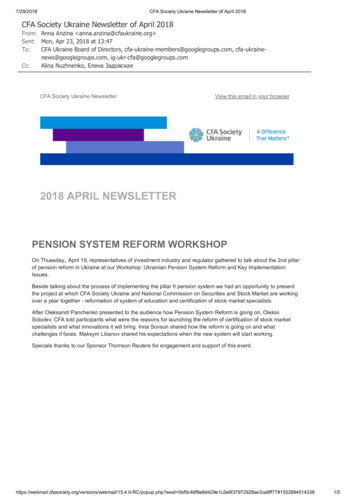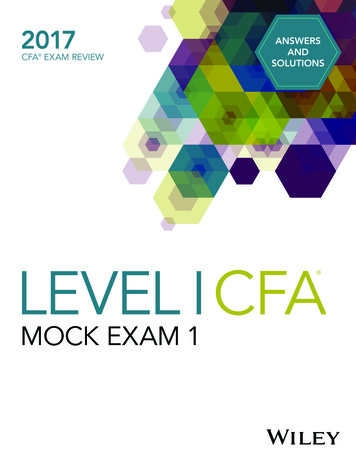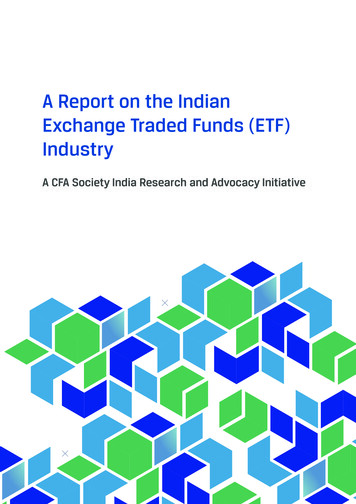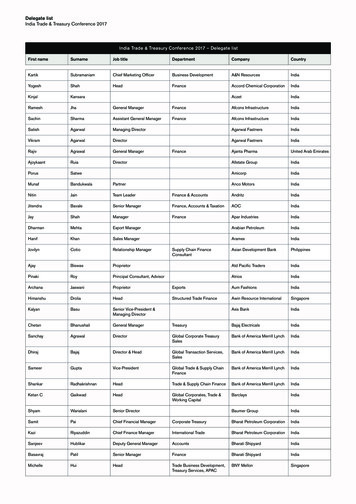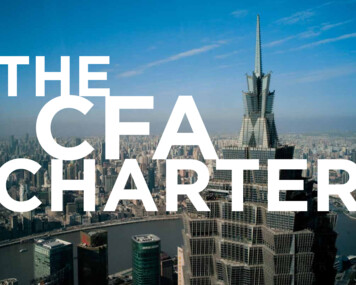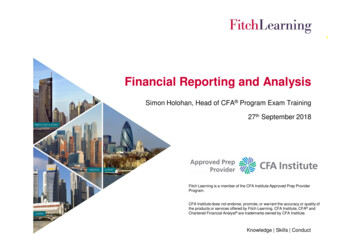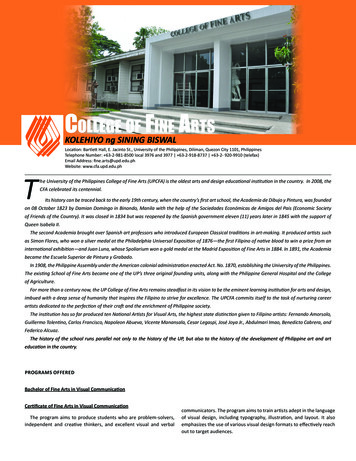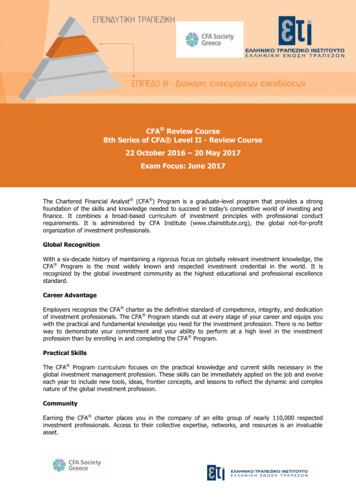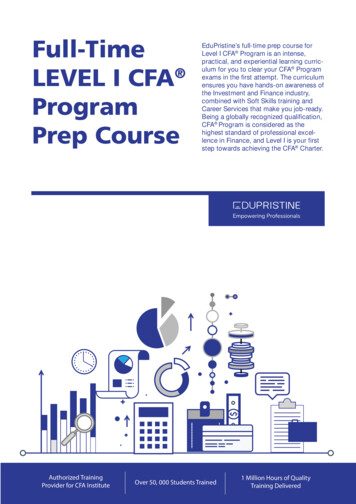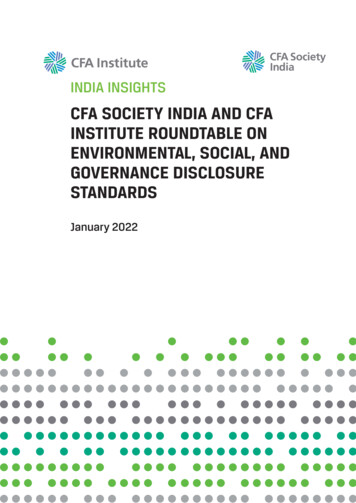
Transcription
INDIA INSIGHTSCFA SOCIETY INDIA AND CFAINSTITUTE ROUNDTABLE ONENVIRONMENTAL, SOCIAL, ANDGOVERNANCE DISCLOSURESTANDARDSJanuary 2022
CFA SOCIETY INDIA AND CFAINSTITUTE ROUNDTABLE ONENVIRONMENTAL, SOCIAL,AND GOVERNANCE DISCLOSURESTANDARDSJanuary 2022
The mission of CFA Institute is to lead the investment profession globally bypromoting the highest standards of ethics, education, and professionalexcellence for the ultimate benefit of society.CFA Institute, with more than 170,000 members worldwide, is the not-for-profitorganization that awards the Chartered Financial Analyst (CFA) and Certificate in Investment Performance Measurement (CIPM) designations. CFA ,Chartered Financial Analyst , AIMR-PPS , and GIPS are just a few of thetrademarks owned by CFA Institute. To view a list of CFA Institute trademarksand the Guide for the Use of CFA Institute Marks, please visit our website atwww.cfainstitute.org. 2022 CFA Institute. All rights reserved. No part of this publication may bereproduced, stored in a retrieval system, or transmitted, in any form or byany means, electronic, mechanical, photocopying, recording, or otherwise,without the prior written permission of the copyright holder. This publicationis designed to provide accurate and authoritative information in regard to thesubject matter covered. It is sold with the understanding that the publisheris not engaged in rendering legal, accounting, or other professional service. Iflegal advice or other expert assistance is required, the services of acompetent professional should be sought.
ContentsIntroduction 1CFA Institute Global ESG Disclosure Standards for Investment Products 2Feedback from global stakeholders on the standard 2The standard and existing regulations 3Trade-off between standardisation and flexibility 3SFDR 3Materiality 4Climate-related disclosures 5Participant Views on ESG Disclosures and SEBI’s Consultation Paper 6Comparison between SEBI’s Consultation Paper and the Standard 8Conclusion 10CFA Society India Volunteer Contributors 11 2022 CFA INSTITUTE. ALL RIGHTS RESERVED.iii
This page intentionally left blank
IntroductionCFA Society India and CFA Institute convened a roundtable on environmental, social, andgovernance (ESG) disclosure practices on 10 December 2021. The roundtable had thefollowing agenda:1. Chris Fidler, CFA, senior director, standards, CFA Institute, discussed the recentlyreleased CFA Institute Global ESG Disclosure Standards for Investment Productsand answered questions on the standards and the state of ESG disclosuresaround the world.2. The participants, including fund managers, asset owners, and other stakeholders representing product, marketing, and communication functions, presentedtheir views on ESG disclosures, the Security and Exchange Board of India (SEBI)consultation paper on ESG disclosure of mutual fund schemes, and the wayforward.3. Mohan Kumar Prabhu, CFA, CFA Society India volunteer, presented a comparison between the CFA Institute disclosure standards and the SEBI consultationpaper, briefly presented the CFA Society India response to the consultationpaper, and answered questions.The following are the minutes of the discussion. 2022 CFA INSTITUTE. ALL RIGHTS RESERVED.1
CFA Institute Global ESG DisclosureStandards for Investment ProductsChris Fidler provided a brief overview of the Global ESG Disclosure Standards for InvestmentProducts (“the standard”), which are ethical standards based on the principles of fairrepresentation and full disclosure. They are designed to communicate information aboutan investment product’s consideration of environmental, social, and governance (ESG)issues in its objectives, investment process, or stewardship activities.The core of the standard is to disclose how asset managers have brought ESG considerations into product design. The standard includes 10 fundamental requirements, relating to how managers need to prepare disclosures and make them available to investors.Sample ESG disclosure statements are useful for managers to see how these requirements come together for various types of products.Feedback from global stakeholders on the standardFidler touched on the feedback CFA Institute received on this standard from asset managers and other stakeholders globally and explained how this feedback influenced changesin the final version. The first topic is categorisation and labelling. When CFA Institutestarted this project, it was open about the standards it wanted to build and felt that labelling and categorisation would help investors understand the different kinds of productsin the market as well as the strategies that might meet their needs. In the first draft, CFAInstitute proposed six different features that could be mixed and matched to create different products. Based on feedback, however, no agreement was reached on the terminologies or how people think about these strategies. The regulators were framing rulesfor different labels and terminologies. CFA Institute realised it needed to make the standard flexible enough to work in all markets. Part of the solution is to not require managersto use certain terminologies as well as not prohibit them from doing so. The final draftincludes a section on terminologies, which provides recommendations but not requirements. These recommendations can be summarized in three points. First, you should useplain language wherever possible. Second, if you have to use specialised terminology,you need to define those terms, which is just good communication practice. Third, wereferenced the terms from our ESG certificate, Principles of Responsible Investment (PRI),and Global Sustainable Investment Alliance (GSIA). In many cases, the terms are similar,and managers can choose among them and define them for their readers.CFA Institute has received good feedback on the final standard. Managers have appreciated the open architecture and the flexibility to frame the disclosures, along with someguidance.2WWW.CFAINSTITUTE.ORG
CFA Institute Global ESG Disclosure Standards for Investment ProductsThe standard and existing regulationsAn important question we asked is how the standard fit with regulations. This issue is pertinent for this group, in keeping with the SEBI consultation paper on ESG disclosures formutual fund schemes. The standard was carefully designed to fit with the regulations. Thestandard is complementary to the European Sustainable Finance Disclosure Regulation(SFDR) and the International Organization of Securities Commissions (IOSCO) recommendations for asset managers on investment product disclosures. SFDR and the Taskforceon Climate Related Financial Disclosures (TCFD) focus on high-level questions. SFDR asksquestions about whether the product has a sustainable investment objective, what strategy the product pursues, and whether the product considers adverse impacts. Thesehigh-level questions are addressed by specific sections in the standard. The standard provides a good blueprint for managers to disclose the information sought by the regulations.Another point of feedback CFA Institute received from asset owners, consultants, andadvisers was that the standard would help them streamline the product search as well asthe manager search process. The standard improves how managers can communicateabout their products with their buyers.Trade-off between standardisation and flexibilityOne participant asked how the standard, which offers flexibility in terms of use and otherdisclosures, could simultaneously provide a degree of comparability across providers.Fidler said the main way it offers comparability is by understanding how a product hasincorporated ESG. An impact product is different from an integration product. For example,the latter does not focus on solar panels. It looks at how the ESG factors, which vary fordifferent securities, affect their risk and return. In contrast, the impact product will havea specific objective, will possibly screen out certain investments, or may have allocationtargets for industries. One could make comparisons at that level. At a more granular level,exclusionary screening criteria, for example, has disclosure requirements like segments,thresholds, and definitions that also can be compared across products.A lot of existing products are like black boxes, and regulators want to standardise themlike, for example, certain inches long or weights. The standard provides a level of information on products with which categorisation and comparisons can be made. If readers lookthrough the four sample disclosure presentations, they will recognise information organised across dimensions and should be able to compare products.SFDRAnother participant said that if a categorisation scheme could accompany SEBI proposals, along the lines of SFDR article 8 (light green) and article 9 (dark green) funds, it wouldhelp the ecosystem. Another participant remarked that SFDR does not make it clear what 2022 CFA INSTITUTE. ALL RIGHTS RESERVED.3
CFA Society India and CFA Institute Roundtable on Environmental, Social, and Governance Disclosure Standardsshould be categorised as article 8 or article 9, and most managers are struggling to categorise their funds accordingly. Some managers are taking a more conservative approachwhereas others are taking a more aggressive approach to classifying their funds. SFDRhas not defined what it means for a product to have a sustainable investment as anobjective. An impact fund clearly could be an article 9 fund. It is ambiguous, however, if aninvestment product makes an allocation to investments that are sustainable accordingto the EU taxonomy, then it might qualify as an article 9 product. Alternatively, it can beviewed as an environmental or social characteristic, which might qualify it as an article8 fund. European regulators did not intend the articles to be used as a label, but theyshould have anticipated this application. When the standard was built, the fact that different disclosure requirements would be triggered by different kinds of products was agood thing, because ultimately this led to categorisation.Another participant asked about the future of SFDR. SFDR is an important initiative, butother regulators are likely evolving their own regulations. Climate disclosure is an areawhere some consensus seems to be evolving. Regardless of how the regulations evolve,the standard could be a guiding north star, because it covers different type of products,across asset classes, and it is market neutral—that is, it is designed to accommodate different investor preferences. The standard does not try to achieve any policy objectives,only product transparency.MaterialityAnother participant asked about materiality, specifically whether the standard requiresasset managers to disclose quantitative criteria on their products, such as carbon orwater intensity.First, the standard does not require the asset managers to build the products in a certainway. Asset managers, however, do need to consider material ESG factors in their activestrategies. Materiality should be interpreted as factors material to the investment objectives of the client. The investment objectives could be risk and return, values, or anythingelse. It is difficult to devise a set of standardised measures for all of the investments in aportfolio, particularly given changing portfolio compositions and the fact that some of themeasures are not widely available or standardised.Another question was raised about who should define materiality: regulators or standardsetters?Materiality is contextual, and it depends on the investment, strategy, time horizons, andclient preferences, among other things. Applying an absolute standard of materiality forwhich judgement is needed is the wrong approach.4WWW.CFAINSTITUTE.ORG
CFA Institute Global ESG Disclosure Standards for Investment ProductsMore broadly, policy makers view finance as a tool to create a sustainable future.Finance plays an important role, but occasionally it has gotten ahead of consumerdemand. A lot of investors do not understand terms such as net zero. It is importantto see some consumer demand in terms of product choices and for policy makersto pull other levers, such as a price on carbon, to achieve the desired outcomes.Climate-related disclosuresDoes the standard cover climate-related disclosures like the TCFD? Or are these disclosures tackled separately outside of the standard?These disclosures overlap. TCFD recommends that managers disclose how they considerESG risks and transition risks. Our standard requires managers to disclose material factors relevant to the investment process, including climate change. TCFD also goes intorisk management and targets. If those targets are part of the product design, they mustbe disclosed as part of the standard. In this way, the standard is complementary to theTCFD asset manager recommendations.Regarding next steps for the standard, CFA Institute plans to release a handbook thatexplains and interprets the provisions of the standard. CFA Institute also will releaseassurance procedures for independent assurance providers to examine the manager’sdisclosures and to test whether they meet the standard. Last, an optional disclosure template will be released to address demand from some asset managers and other stakeholders to aid standardisation and comparability. 2022 CFA INSTITUTE. ALL RIGHTS RESERVED.5
Participant Views on ESGDisclosures and SEBI’sConsultation PaperFollowing the presentation, the participants shared their initial views on ESG disclosuresand SEBI’s consultation paper. One participant felt that SEBI’s proposal for fund managersto report on stewardship and engagement on every ESG product is expansive and addsto compliance burden. Currently, stewardship reporting is done at the fund house level,and if a fund house has multiple funds, the engagement with the issuer is not differentacross funds.At this point, we remarked that stewardship reporting in India is nascent, primarily viewedas a compliance exercise, and mostly lacking a narrative explanation of how fund managers are engaging with companies. We asked participants if stewardship reporting for ESGfunds could nudge funds to take a different tack and report their engagement with companies in a meaningful way. To this, a participant responded that most of their engagement happens with companies that do not consider sustainability in their business. Theholdings in the ESG fund, however, are selected carefully among those that are performing well on the ESG dimensions, which might be a fraction of the companies the analyst engages with. The analyst in this case might report not only which companies sheengaged with but also the level of engagement, the topics of engagement, and votingdecisions with reasons. Therefore, if you require engagement at the ESG fund level, andnot just at the fund house level, you will end up with multiple reports on the same holdings at the fund house, the mutual fund, and the portfolio management services levels.A second aspect in the SEBI’s paper is difficult at this stage—that is, funds should demonstrate real-world outcomes. Most funds consider ESG aspects within the investmentprocess, without looking at the real-world outcomes or impact that their funds are creating. It is better to focus on ESG risks and opportunities that are being considered as partof the product.SEBI’s Business Responsibility and Sustainability Reporting (BRSR) is mandatory for top1000 companies. One participant said that SEBI’s proposal to make BRSR disclosure mandatory for inclusion in ESG funds might disincentivise small-cap funds, which may investoutside top 1000 companies, to become ESG oriented. Therefore, as long as there aresome ESG disclosures, it is better to not make BRSR mandatory. CFA Society India alsodiscussed this issue and arrived at the same recommendation. Some participants questioned that view, saying ESG funds are given the flexibility of adopting ESG considerationsonly up to 80% of the investments. Investments beyond the top 1000 companies, which6WWW.CFAINSTITUTE.ORG
Participant Views on ESG Disclosures and SEBI’s Consultation Paperare microcaps, are likely small. Therefore, it was not necessary to make BRSR optional.The economics made perfect sense, but the recommendation for not making it mandatory was based on a principle that asset managers should be allowed to make their judgements about ESG factors of a company and should not be restricted by BRSR disclosurerequirements.One participant remarked that it is difficult for public funds to demonstrate impact outcomes, one of the categories in the paper. He felt that it is easier for investors in privatemarkets to create impact outcomes than for public funds, which have small stakes inpublic companies, to do the same. Another participant agreed and said perhaps impactin the public context means investing in certain segments, such as education or healthcare, which are oriented towards certain social outcomes.Another participant suggested that the dates for implementing the BRSR requirement forfunds should be rolled forward by one year, because BRSR is made mandatory for top1000 companies only from March 2023. He also suggested that imposing standardisation at such an early stage of ESG investing is not conducive for innovation. Presently,ESG is viewed primarily through a risk lens. In time, ESG may be considered in terms ofopportunities, and that would be the time to mandate disclosures on impact and otherdimensions.One participant remarked that the consultation process got it backwards, viewed from aregulator and fund manager perspective. When the participant asked investors why theyinvest in ESG funds, almost everyone said they wanted better returns than the benchmark. Sovereign wealth funds might take an enlightened ESG perspective, but investorscare about returns. The SEBI consultation paper does not recognise this perspective. Weasked participants if the disclosures could bring about a change in mindset and play aneducational role surrounding sustainability considerations, rather than wait for investor attitudes to change. One participant said that the disclosure requirements has comeabout because of the change in perception, however small. Another participant said theawareness about what these funds stand for is important. Disclosures are a first step,and we need to see how attitudes evolve. 2022 CFA INSTITUTE. ALL RIGHTS RESERVED.7
Comparison between SEBI’sConsultation Paper and theStandardMohan Kumar Prabhu walked the participants through a comparison between SEBI’s consultation paper on ESG disclosures and the standard.SEBI’s proposals are a combination of firm-level, product-level, and periodic disclosures,although they are not structured as such. The proposals cover policies and procedures,in addition to disclosures. CFA Institute ESG disclosure standards, however, cover onlydisclosures, and therefore our comparisons are limited.On firm-level disclosures, SEBI’s proposals cover a responsible investment policy anddisclosures around ESG investing on the firm’s website. The responsible investmentpolicy includes the universe of companies the fund invests in, the processes to reviewinvestments, and the expectation that the investments generate a beneficial sustainable impact alongside financial returns. The website disclosures cover aspects relatedto ESG investing like information sources, investment processes and philosophy, key ESGfactors, and engagement policies. CFA Society India recommended that the disclosureson the website be aligned with other disclosures in the Scheme Information Documents(SID) and Key Information Memorandum (KIM), and website disclosures, such as ESG datasources, and key ESG factors should be made part of the product disclosures.One participant asked what a beneficial sustainable impact means. We remarked that, inpractice, it could mean a better ESG score, even if the scores are subjective.On product-level disclosures, the distinction between SEBI’s disclosures and the standard is subtle. SEBI ties the investment objectives with the nomenclature of the fund; thestandard does not cover naming but rather requires managers to disclose any third-partylabels and certifications that the investment product complies with, and those certifications or labels might cover naming conventions. Also, the detail in SEBI’s consultationproposal varies across investment approaches—for example, an investment strategythat incorporates screening or exclusions has detailed disclosure requirements, such asthe characteristic or type of exclusion, thresholds, and reference to third-party guidelines, whereas a best-in-class or positive screening approach merely requires funds todisclose “details and specifics of the metrics.” The standard provides detailed guidanceacross approaches. The standard also has fewer investment approaches compared withSEBI’s consultation paper because it combines similar ones—for example, for the purpose8WWW.CFAINSTITUTE.ORG
Comparison between SEBI’s Consultation Paper and the Standardof disclosures, best-in-class/positive screening or exclusions/negative screening aretreated as one approach. Likewise, for the purpose of disclosures, impact investing andsustainable objectives also are combined in one approach.For some investment objectives, the standard requires disclosures that are complementary to SEBI’s proposals. For example, for an impact investment objective, the standardrequires managers to disclose how the impact objectives are expected to be attained, theeffect of investments on environment and governance issues, and how adverse impactsare managed. In addition, the standard also requires managers to disclose the stakeholders who are expected to benefit, discuss any trade-offs between impact and financialobjectives, and explain how the impact objectives contribute to Sustainable DevelopmentGoals (SDGs), if stated.We asked participants how they differentiated an impact investment strategy and a sustainability objective. One participant responded that impact investing needs a beneficiary,whereas sustainability objectives are related to SDGs, but some could overlap. Otherssaid sustainability objectives would require investing in companies that have great potential from an ESG perspective, like clean tech or sustainable agriculture. These objectivesmight have an impact as well, but they are defined primarily in terms of opportunities. 2022 CFA INSTITUTE. ALL RIGHTS RESERVED.9
ConclusionIn summary, CFA Society India recommended that SEBI’s proposals be structured in termsof firm-level, product-level, and periodic disclosures, for readability. Required disclosuresand recommendations related to practices, policies, and procedures of the fund shouldbe differentiated. SEBI also may consider additional disclosure requirements from the CFAInstitute disclosure standards to refine its own disclosure requirements and to facilitatefair representation and full disclosure of an investment product’s ESG considerations.10WWW.CFAINSTITUTE.ORG
CFA Society India VolunteerContributorsMohan Kumar Prabhu, CFAShamit Chokshi, CFAAparna ShankerAnkur Gupta, CFAJolly Balva, CFAShazia Naik, CFANishant Shekhar, CFA 2022 CFA INSTITUTE. ALL RIGHTS RESERVED.11
This page intentionally left blank
THE AMERICAS(800) 247 8132 PHONE (USA and Canada) 1 (434) 951 5499 PHONE 1 (434) 951 5262 FAX915 East High StreetCharlottesville, VA 22902USA477 Madison Avenue21st FloorNew York, NY 10022USAASIA PACIFIC 852 2868 2700 PHONE 852 2868 9912 FAX23/F, Man Yee Building68 Des Voeux RoadCentral, Hong Kong SARSi Wei Beijing Enterprise Management Consulting Company LimitedUnit 7, Level 12, Office Tower C1, The Towers, Oriental PlazaNo 1 East Chang An Avenue, Dong Cheng DistrictBeijing, 100738, ChinaCFA Institute India Private LimitedNaman Centre, Unit No. 1031st Floor, Bandra-Kurla Complex, G Block, Bandra (East)Mumbai 400 051, IndiaEUROPE, MIDDLE EAST, AND AFRICA 44 (0) 20 7330 9500 PHONE 44 (0) 20 7330 9501 FAX131 Finsbury Pavement7th FloorLondon EC2A 1NTUnited KingdomRue du Champ de Mars 231050 Brussels, Belgiumwww.cfainstitute.orginfo@cfainstitute.org
1. Chris Fidler, CFA, senior director, standards, CFA Institute, discussed the recently released CFA Institute Global ESG Disclosure Standards for Investment Products and answered questions on the standards and the state of ESG disclosures around the world. 2. The participants, including fund managers, asset owners, and other stakehold-
